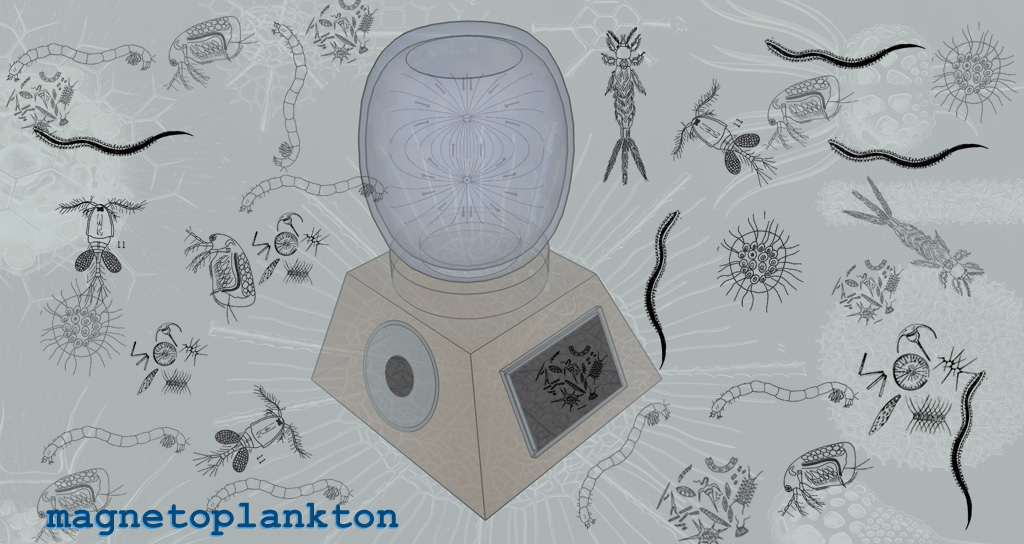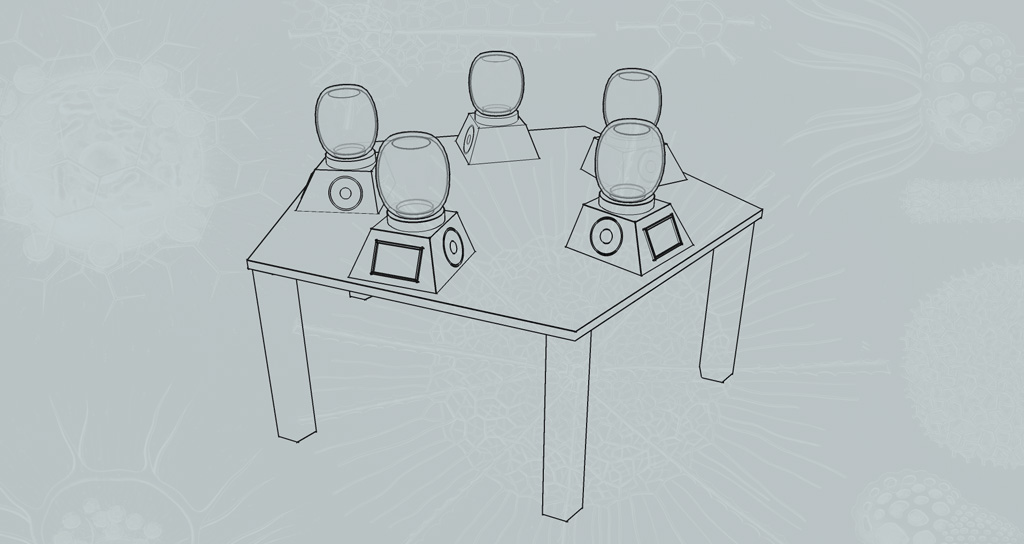
Magnetoplankton
The artificial plankton, called the "magnetoplankton" - a term derived from the Latin (magnes, -etis, magnet), and plankton (from the Greek πλαγκτός, planktos, wandering) – is a lab specimen that lives in glass tanks with water samples and live plankton, magnetic micro-robots that dynamically respond to variable oscillations in electromagnetic fields processed in real-time by feedback algorithms. Experiments on artificial life structures that seek a symbiotic relationship with their environment through processes related to fields studied by magneto-chemistry, the hypothesis of this artistic experiment raises the idea that life, by being structured in the environment of the water molecule, perceives subtle energy oscillations: the diamagnetism of water that affects its surface tension, causing oscillations that generate links with other elements of energy systems.
Thales of Miletus, considered by history to be the first philosopher for his rational study of natural phenomena, believed water to be the source of life, from which everything precedes and to which everything returns. He was the first to study electricity and magnetism, a force he believed to be similar to the soul and which was present in all particles, each of which was a god. For Aristotle, Thales de Miletus was the first to suggest that all matter was constituted by a single substrate. In addition to his attempt to explain nature by simplifying observable phenomena and searching for causes within the natural environment itself, and as a result of these reductionist elements, Thales used an empirical approach to unravel the mysteries of physical life that are most awe-inspiring and are therefore interconnected: the electromagnetic field and the water molecule.
Recent studies in magnetochemistry have considered water's powerful molecular bond to be the basis for its complex properties: it is the covalent bond which occurs in electron spin pairs that generates the picosecond links in molecular bonds, in clusters of five molecules, with each water molecule linked to four other water molecules.
Proposal
Metallic micro-robots are exposed to an electromagnetic pulse to induce a residual magnetic field through hysteresis; these robots endowed with a magnetic memory will inhabit a glass tank that will be placed on an induction coil wound with enamelled copper wire. A micro-controller will generate variable voltage pulses that will be amplified and emitted to the coil, producing electromagnetic fields at variable frequencies. The micro-robots will then react to these fields by exhibiting kinetic properties. The physical reaction to these movements will produce micro-sounds in the glass structure which will be amplified by piezoelectric and neodymium speakers. The variables that produce the oscillations will be obtained through specific sensors reacting to the conditions of biological processes, which will feed the different systems with data, establishing communication between the various tanks. These tanks, managed by scientific protocols, will sustain living plankton colonies. The public, using portable digital microscopes, will observe the microscopic plankton life and the magnetoplankton on a small LCD screen. By moving the microscope lenses closer to the tank the public will influence the micro-robots via the neodymium magnets surrounding the lenses. The micro-robots will exhibit unexpected reactions when affected by these new magnetic fields in their surroundings. Five tanks will be built to be placed on a pentagonal table.
Project: de Arcangel Constantini
comision by
Emergencies 2012 Cultivamos Cultura Portugal <
Curator, Marta de Meneses , Produccion Catarina Cerdeira
residency @! EngageLab Computer Graphics Centre University of Minho)
support Arte+Ciencia UNAM Mexico
Dra. Maria Antonia Gonzalez Valerio ( teoría ), Dra. María Ana Fernández Álamo ( biología )
Models,CNC > Santiago Itzcoatl . taller: La Metropolitana
-------------------------------------------------------------------------------------------------------------------------------------------------------------------------------
Magnetoplankton. Vidas minúsculas en movimiento
Maria Antonia Gonzalez Valerio.
1. Artificial life or robots in motion.
Is it by chance that movement has always been considered one of the essential characteristics of living beings? Considered in this way, attempts have been made not only to affirm that autonomous movement is a key characteristic of living beings but also to investigate how movement is produced, what its cause might be, how it affects living beings, and what kinds of movements there are or might be. In this context, to animate the inanimate means to give it movement, preferably autonomous movement, and to make it react to exterior stimuli.
It is a question of building miniscule robots that imitate the tiny size of the organisms which gather and live as plankton, making vertical movements, and which define life in water, both fresh and salt.
We need to create movement, to define its cause – or not – and, most importantly, to avoid directionality. It has to be a special kind of movement that corresponds to the project of creating bioartificiality in the area where art, science, and technology intersect.
In this case, bioartificiality is produced, not with living organisms, but by creating and recreating some of life's functions, which involves subverting life, not through its materiality, but through its functionality. This subversion does not play at duplication – it is not a question of creating an "as if", as if the robots were alive – but of creating new ways of being alive, of opening the space-time in which the living might occur in a different way. Occurring as a machine moving in water, in a game of mechanisms without purpose or effort. Living in water as a moving robot, as an artefactual or bioartefactual entity, because it must be remembered that life or living lies not just in materiality – it is not only the material cause which will govern the living – but also in its formal cause, the final cause which produces movement. Here, there are no living organisms in materiality, but it is only in that sense that there are none.
However, where does movement come from? What kind of movement are we dealing with here? It is interesting to observe a kind of movement which can be understood rhizomatically; that is, instead of having a linear, fixed, monotonous directionality responding to its own impulse, this movement is dispersed in time and space thanks to its relationship with the other. In this context, the other is represented by water and magnetic energy.
A planktonic artefact traversed by magnetic forces. The movement does not belong to the robot as an agent, a cause-subject determining what it is and the way it is, but to the point in which movement occurs and in which the robot moves. Autonomy of movement? Yes, autonomy of movement and not of the agent acting as the cause, the controller, the governor of its own movement. And although life is usually defined biologically, with autonomous movement being included as one of its essential functions, what we present here is the subversion of life through a multiple movement consisting of movements interacting with each other, or rather forces interacting with each other, and forces interacting with substances such as water and metal, which, in turn, are nothing more than what is rhizomatically moved.
"Rhizomatic" movement is not equivalent to "chaotic" movement. By describing it in this way, what I am trying to highlight, in reference to planktonic robots, is that it generates relationships, connections, determinations and the result it is that it is impossible to see the robot as autonomous machine. On the contrary, it is overtaken by movements and forces that belong equally to it and to the other. In other words, it is impossible to identify or separate the other and the self. "Make rhizomes, not roots, never plant! Don´t sow, grow offshoots! Don't be one or multiple, be multiplicities! Run lines, never plot a point! Speed turns the point into a line. Be quick, even when standing still!" (Deleuze and Guattari, "Rizhome").
What arises from these movements, these relationships, these interactions? How are planktonic robots realized?
Multiplicities which become sentient not only in the movements, but also in the plankton….
2. Live plankton culture or live ars
To present a world in its two possibilities. To present bio-artificiality in its two modes of being. To open a connecting space through which artefacts and living organisms are filtered. Robots on one side, plankton on the other. The former are given life through movement, the latter are rendered artificial through the image; in any case, they both acquire another mode of being when subjected to the perverse reciprocity that duplicates one in the other. Seeing themselves in the other which, however, is not (its other).
The plankton has a diversity that it has not yet been possibly to classify; a synthetic and extremely condensed sample that allows us to see that it is all there is, that the material overflows in such a way from its multiplicities that it is more convenient to focus on the multiple in multiplicity, with no unity, no point of synthesis or concentric reunion from which to glimpse the unity, the single. Heterogeneity remains and becomes present without harmony. It is the other of the other and is therefore deprived of anything by which to relate or condense that multiplicity. There is no point of support, because there is no unity. To see, and to see, and to see, and to keep seeing a universe that cannot be determined and that it might be possible to hold in my hands, or rather representatively in the hundreds of flasks piled up in a lab. Hypotheses thrown at the glass.
Nor does multiplicity allow itself to be reduced to quantification, as if we could only say that there is "a lot". It is not even a question of saying that everything or almost everything that exists and will exist as a life form in water or in transit through water is contained in an embryonic state in the plankton. It is not the origin (arché) of what will arise afterwards. It is the multiplicity that can only be perceived by a gaze that does not attach itself to anything and avoids unity from the outset. There is no beginning.

Proposal : Five Modules in a Pentagonal table, representig a cluster of water molecules